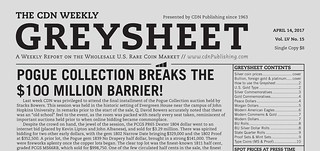
PREV ARTICLE
NEXT ARTICLE
FULL ISSUE
PREV FULL ISSUE
PRICE TRANSPARENCY AND THE $100 MILLION BARRIER
This post from the Coin Dealer Newsletter blog makes a good point about the benefits of price transparency in the rare coin market.
-Editor
Despite the crowd on hand, the jewel of the session, the PCGS PR65 Dexter 1804 dollar went to an internet bid (placed by Kevin Lipton and John Albanese), and sold for $3.29 million. There was spirited bidding for two other early dollars, with the gem 1802 Narrow Date bringing $329,000 and the 1802 Proof at $352,500. A prior lot, the Pogue gem 1839 No Drapery half dollar, brought in a strong $141,000. There were fireworks aplenty once the copper lots began. The clear top lot was the finest-known 1811 half cent, graded PCGS MS66RB, which sold for $998,750. One of the few circulated half cents in the sale, the finest known 1802/0 graded PCGS XF45, blew away its estimate to sell for $199,750. This auction contained two AU 1793 Liberty Cap large cents, both of the Sheldon-13 variety. The PCGS AU58 coin brought an eye popping $940,000 while the PCGS AU53 sold more reasonably for $376,000. Arguably the most visually appealing large cent in the sale, the PCGS MS67RB 1794 Apple Cheek brought down $446,500. The finest known 1796 Liberty Cap cent of any variety, the PCGS MS66+RB, exceeded even the most optimistic of estimates at $705,000. Among the later date cents, the only known mint state 1839/6, PCGS MS65+BN sold for a record $376,000. All together, the cents brought more than $12 million. A special moment occurred a little over halfway through the sale when the announcement was made that the Pogue collection had surpassed the $100 million mark. All told, the fifth part of the collection totaled a bit over $21.4 million for a grand total of $106.72 million. Despite the fact that the Pogue coins are beyond the budget of many collectors, there are benefits and lessons to be drawn here that are important to recognize. First, the sale of coins on this level attracts the attention of individuals willing to enter the market with substantial funds, because they see the solid foundation of the coin market and do not have to worry about long-term stability. The Pogues did very well financially on many of the coins in their collection, and a savvy individual will recognize this. One of the greatest and underrated aspects of the rare coin industry—when compared to other collectibles—is the amount of research data on prices and price performance available to the buyer. Nowhere else can one find this type of transparency and market driven pricing in the spectrum of collectible objects.
There was a time when dealers and advanced collectors hoarded historical pricing information, using it to their advantage to buy low and sell high. But along with the internet came public auction archives from Heritage and other major dealers, making this data available to anyone. While margins have slimmed, price levels and market volume have soared. Are we on the cusp of another sea change in the hobby? It's not just pricing data being made freely available. The internet has brought a large amount of non-price information out in the open, in the form of personal and club web sites, and the digitization of out-of-print numismatic books and periodicals by Google and others. With the advent of the Newman Numismatic Portal, over a million pages of numismatic literature provided by its sponsor and partners are available in a single searchable index. This ready availability of information could help draw and retain the interest of new collectors and researchers, particularly among the younger generation. -Editor
To read the complete article, see:
The Numismatic Bibliomania Society is a non-profit organization promoting numismatic literature. See our web site at coinbooks.org. To submit items for publication in The E-Sylum, write to the Editor at this address: whomren@gmail.com To subscribe go to: https://my.binhost.com/lists/listinfo/esylum All Rights Reserved. NBS Home Page Contact the NBS webmaster 
|
